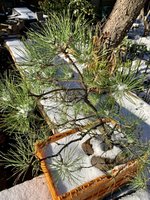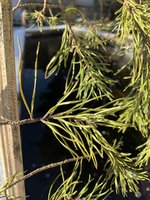Trempie4
Sapling
Absolute newbie here with a long time interest in bonsai. That said, definitely a green thumb but no experience with bonsai, a few potted Japanese maples in my backyard, and lots of perennials. At 53 yo w a poor track record of male longevity in my lineage bonsai seems silly but what the heck, off I go. Location background: Baltimore city with 20' wide backyard, with about 20 sq ft of available space so it will never turn into a hoarding hobby although I've planted the seeds of backyard maintenance for my neighbor in exchange for another 10' of dead space in the back of their yard, that's still in negotiation.
Covid, a lack of business travel opportunities related to covid, and a brother in law with a mountain house in WV where I've seen a lot of inspirationally gnarled "mountain pines" has led to the resurgence of interest in the hobby. My fossil hobby also keeps me in potentially interesting areas where trees of character can occasionally be found.
I read a few forum posts which I though I had explained the overall basics of successful wild collecting and transplanting back home but in delving deeper into the weeds I've discovered that I've most likely already made flaws that will lead to the demise of the everything I've brought home with a trunk diameter thicker than 1/4". I've been able to collected a few fun and potentially interesting pines (to me at least and thankfully this hobby is semi-subjective and artistically generous) from the following locations:
1. Loblolly - Smithfield, VA (I believe this is a loblolly but feel free to correct if incorrect)
2. Pitch Pine(s) - NJ Pines Barrens area
3. Unknown Pine - Lost River, WV (some ID assistance on this one would be greatly appreciated) (looks like 2 needles with a 1-1.5" needle length which is nice!)
The common issue to each of these collected trees is that the soils from which they were collected were so sandy (VA and NJ specimens) or porous in the case of the WV tree that there were no actual root balls. Rather, there were radial root whips that, in the 2 pitch pines, were as long as 6-8 feet, and on the WV specimen only a tap root and a single lateral root about 1/4" in thickness were available with almost nothing smaller. The VA loblolly had what I consider the most potentially significant root "ball", but that is a generous description.
Suffice it to say, root reduction efforts to get them into the containers in the associated photos far exceeded the recommended 25% for pines. I guess we will see what happens over the next 6-12 months. And of course, collection time was between October and early December for the pitch pines so that timing was off as well (I assume).
Here's hoping these guys are motivated to survive and they push out some feeders sooner rather than later.
Pics to follow in a follow-up posting....
Feel free to comment, critique as needed, and save the criticism for private comments amongst yourselves!
Happy Holidays; Hannukkah, Kwanza, Diwali, Hijiri, Winter Solstice, Merry Christmas and a Happy New Year to everyone.
Stay safe and hopefully 2021 is better than this one! Thanks in advance for your assistance and insight.
Lewis!
Covid, a lack of business travel opportunities related to covid, and a brother in law with a mountain house in WV where I've seen a lot of inspirationally gnarled "mountain pines" has led to the resurgence of interest in the hobby. My fossil hobby also keeps me in potentially interesting areas where trees of character can occasionally be found.
I read a few forum posts which I though I had explained the overall basics of successful wild collecting and transplanting back home but in delving deeper into the weeds I've discovered that I've most likely already made flaws that will lead to the demise of the everything I've brought home with a trunk diameter thicker than 1/4". I've been able to collected a few fun and potentially interesting pines (to me at least and thankfully this hobby is semi-subjective and artistically generous) from the following locations:
1. Loblolly - Smithfield, VA (I believe this is a loblolly but feel free to correct if incorrect)
2. Pitch Pine(s) - NJ Pines Barrens area
3. Unknown Pine - Lost River, WV (some ID assistance on this one would be greatly appreciated) (looks like 2 needles with a 1-1.5" needle length which is nice!)
The common issue to each of these collected trees is that the soils from which they were collected were so sandy (VA and NJ specimens) or porous in the case of the WV tree that there were no actual root balls. Rather, there were radial root whips that, in the 2 pitch pines, were as long as 6-8 feet, and on the WV specimen only a tap root and a single lateral root about 1/4" in thickness were available with almost nothing smaller. The VA loblolly had what I consider the most potentially significant root "ball", but that is a generous description.
Suffice it to say, root reduction efforts to get them into the containers in the associated photos far exceeded the recommended 25% for pines. I guess we will see what happens over the next 6-12 months. And of course, collection time was between October and early December for the pitch pines so that timing was off as well (I assume).
Here's hoping these guys are motivated to survive and they push out some feeders sooner rather than later.
Pics to follow in a follow-up posting....
Feel free to comment, critique as needed, and save the criticism for private comments amongst yourselves!
Happy Holidays; Hannukkah, Kwanza, Diwali, Hijiri, Winter Solstice, Merry Christmas and a Happy New Year to everyone.
Stay safe and hopefully 2021 is better than this one! Thanks in advance for your assistance and insight.
Lewis!









